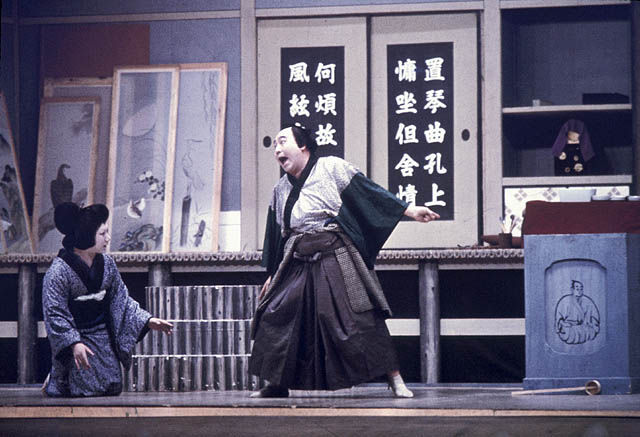| DALEY AT EXPO Japanese Kabuki Theatre Experience of Magnitude By Frank Daley of The Ottawa Journal MONTRÉAL -- Although Expo's World Festival at the moment has no funds to which to advertise the Japanese Kabuki theatre's appearance here, it's a safe bet that the company will have full houses because the word of mouth should attract thousands to this unique blend of mime, music, dance and drums. Simple yet elegant sets and lavish costumes are utilized with the Kabuki technique of "the frozen moment" wherein actors suddenly cease their movement and freeze in a particularly revealing pose and all this combines to create effects which are humorous or moving. The Kabuki tradition is almost 400 years old. It was begun by a woman who toured the country singing Buddhist songs interwoven with erotic humor. Young men and women were drawn to the new form and the word "Kabuki" was used to describe their performances. WOMEN BANNED The group ran into trouble when it became associated with prostitution and the government banned women from the stage. This influence holds to the present time: all women's roles in Japanese Kabuki theatre are performed by men. A perfect example was last night's first play, which tells the tale of a woman, half crazy with grief because of the abduction of her son. The woman meets a kind boatman who relates to her how a man passed by months before with a small child. The child became ill, and the kidnapper left it to die across the river. Together the two leave flowers on the child's grave but the woman continues her grief.
Photo credit: © National Archives of Canada The Japanese Kabuki theatre performance at Expo 67 FEMALE IMPERSONATORS The role of the woman in the production is played by Utaemon Nakamura, Japan's foremost actor in female roles. These female impersonators are not to be confused with those in our country who play in nightclubs. The Japanese actors are highly skilled and talented and can easily make you forget they are not women. The second play (the group brought a selection of five plays from a repertoire of 300) was on a grander scale. It involved some 13 actors and 17 musicians. The costumes were lavish and the sets simple but beautifully hand-painted. The play dealt with a Japanese folk-hero on the run from a jealous brother. The hero disguises himself as a priest and his servants impersonate him at the border. The servant convinces the guards that he is the master by beating the disguised hero for an infraction. The guards impressed, allow the "priests" to escape. FROZEN MOMENT There is much humor and tension in this work, called "Kanjincho". The frozen moment, the stylized postures, the crossing of the eyes in which actors fix each other with a concentrated and meaningful stare are all used to great effect. The conventions of the Kabuki style of theatre are rigid and the style itself is difficult to become accustomed to in one evening. But the Japanese have chosen two representatives and brief works for each evening and the actors are excellent. The Kabuki theatre performances here are theatre experiences of magnitude and should not be missed by anyone interested in theatre. - End of article. Copyright by The Ottawa Journal, August 5, 1967. All rights reserved.
|

